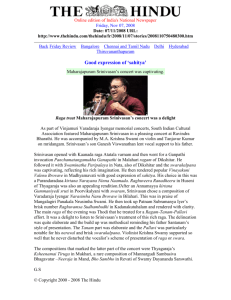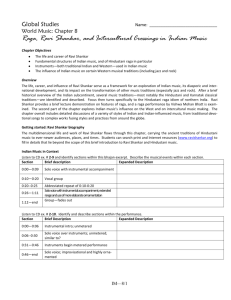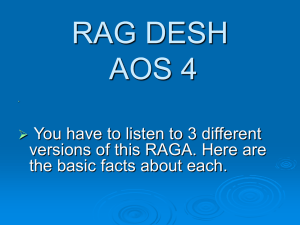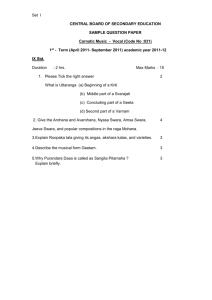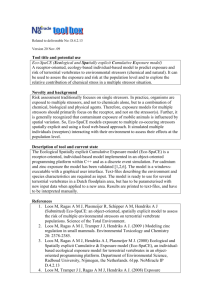Raga and rasa- Mood in music. Discuss the elements which portray
advertisement
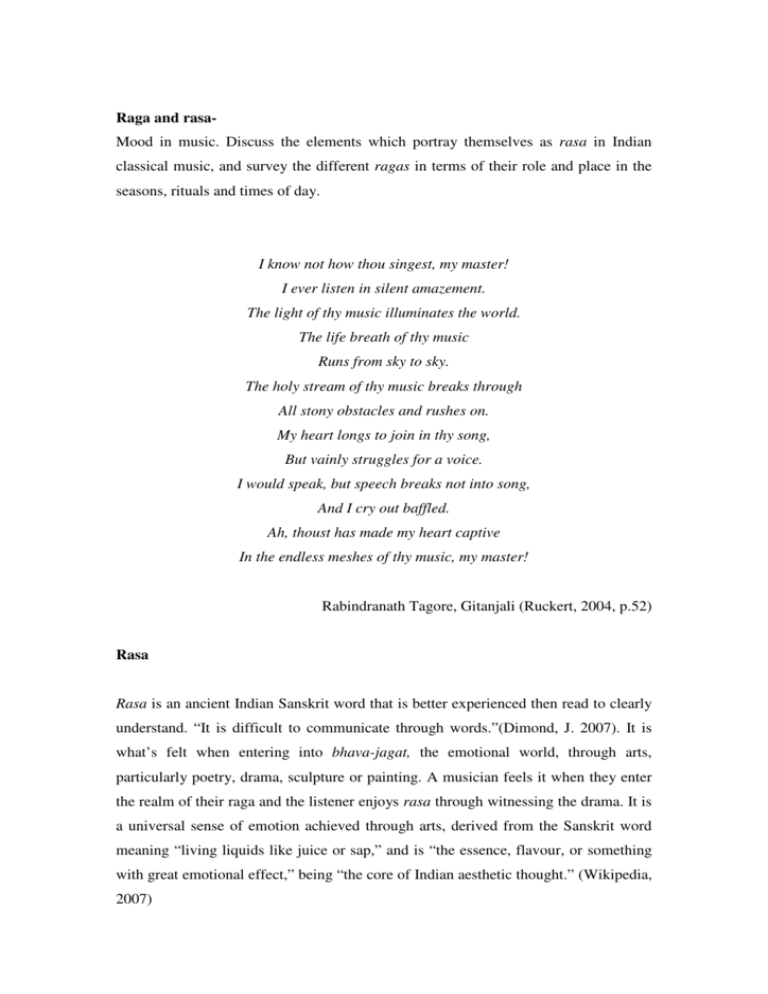
Raga and rasaMood in music. Discuss the elements which portray themselves as rasa in Indian classical music, and survey the different ragas in terms of their role and place in the seasons, rituals and times of day. I know not how thou singest, my master! I ever listen in silent amazement. The light of thy music illuminates the world. The life breath of thy music Runs from sky to sky. The holy stream of thy music breaks through All stony obstacles and rushes on. My heart longs to join in thy song, But vainly struggles for a voice. I would speak, but speech breaks not into song, And I cry out baffled. Ah, thoust has made my heart captive In the endless meshes of thy music, my master! Rabindranath Tagore, Gitanjali (Ruckert, 2004, p.52) Rasa Rasa is an ancient Indian Sanskrit word that is better experienced then read to clearly understand. “It is difficult to communicate through words.”(Dimond, J. 2007). It is what’s felt when entering into bhava-jagat, the emotional world, through arts, particularly poetry, drama, sculpture or painting. A musician feels it when they enter the realm of their raga and the listener enjoys rasa through witnessing the drama. It is a universal sense of emotion achieved through arts, derived from the Sanskrit word meaning “living liquids like juice or sap,” and is “the essence, flavour, or something with great emotional effect,” being “the core of Indian aesthetic thought.” (Wikipedia, 2007) Various Upanishads (Musical Families) explain rasa in different ways. Taittiriya Upanishada describes rasa as an essence, something which is beyond senses. Kaushitaki Upanishada understands rasa as a sacred mantra in verse form called Brahman,and Isha Upanishada describes rasa as something that appeals to, and moves the mind. (Wikipedia, 2007) Sage Bharat (ninth century A.D.) delved into the meaning of rasa and its connection with the complexity of man’s/woman’s emotions and sentiments, explaining how rasa emits from a medium and affects the audience. Why does it delight? He replies “because it can be savoured.”(Wikipedia 2007) Bharat believed the “world of emotions” consisted of eight inherent emotions or sentiments, which were established in the fourth century CE although this time frame is somewhat disputed amongst resources. The original eight are; 1. Karuna – sadness, pathos 2. Shringar – love, joy 3. Vira – heroism, valour 4. Hasya – laughter, comedy 5. Raudra – anger 6. Bhayanaka – fear 7. Vibhatsa – disgust 8. Adbhuta – surprise Sources claim in the tenth century a ninth rasa of peace, Shanta, and a tenth *1, shyness, Laija rasa have been added. But it would seem, due to the thematic nature of Indian Classical music that shanta existed a long time ago, as all lineage originates to the sacred Vedas (lit: knowledge); the oldest scriptures dating back 1500 BC. An understanding of these texts perhaps allows deeper appreciation of Indian music; but is not vital to experience rasa; sourced as just one emotion; the most important of all emotions, in which the mind can perpetually rejoice. Through serious music one can “bring oneself in tune with the highest planes.” Hindus interpret this experience of music as Nad-Brahma, “sound as God,” or “the language of God.” (Ruckert, 1996, p.18) Art historian, Ananda Coomaraswamy, notes that these sounds are, “Created by 1 * Wikipedia God,”…“and they were passed down through the rishis (saints) to help (mankind) purify the mind and soul.” (Ruckert, 1996, p.38) But there are also thirty-three temporary emotions (outward behaviours), and other emotions secondary to the original eight emotions. These are bhavas, (expressions) or shades of the first eight, and a musician spends years in riaz (practise) to effectively communicate these to an audience. But there are so many; rasa shringar from “above”, holding bhavas of happiness, joy, enchantment, wonder, ecstasy, infatuation, adoration, eroticism, devotion ect. (Ruckert, 1996, p.29) The emotional world in the arts and human psychology hold many more emotions then just shanta. This helps explain why there are theoretically thousands and thousands of ragas in Indian music that relate to occasions requiring specific moods at specific times of the day and year. If a musician can genuinely feel the emotion or mood through playing his/her instrument and convey that to the audience; if the audience are then lured by the intoxicating nature of that emotion/ mood, then that emotion becomes “universalized”, it belongs to everyone. Indian aestheticians call this “sadharanikarana.” (Wikipedia, sadharanikarana, 2007) But when in the performance does this occur? Shen Flindell, an Australian tabla player living in Japan, says upon initiation of a performance, “the musician feels emotion first then brings that out by manipulating the chosen notes.” Flindell’s initial outward sign of emotion is respect for his guru (teacher) is shown by touching his own forehead or his third eye perhaps in remembrance of him. The gurus are highly respected by their students, who spend their lives in riaz polishing skills until they have attained taiyari (ripeness). Older musicians after many years riaz and taiyari attain sadhana (spiritual practise). Theoretically the level of musicianship and spiritual insight are stronger therefore the rasa shines brighter, as the bhava is more developed. (Ruckert, 2004, p.27). Also note the organic nature of Classical Indian musical instruments is just as important a vehicle for creating rasa as the musicians themselves. Even down to the traditional coconut plectrums and horse hair violin strings; for a musician to successfully communicate natural emotion, it would make sense that organic materials would best resonate emotional vibrations. Raga In Sanskrit ‘Raga’ literally means “colour” or “mood”; similar to rasa but involving specific musical rules or guide lines. This is kind of a grey area when it comes to differentiating between a few Sanskrit words that start with “ra”; like ranj, which means to colour with emotion. Raga, involves many features beyond scalic classification, including purpose and intention. In Indian classical music, a raga is performed at a set time of day or season with the intention of evoking specific moods within the listener and self; very much like theatre and paintings, which were closely related mediums of communication. In theory, I could research 1,000’s of unique ragas with different names and purposes; some musicians even claiming there are up to 75,000; but in practise only fifty of these are often used. A series of five notes or more are used to classify the melodic line of a raga. Soloists then use these notes as well as grace notes and shruti (micro-tones) to create lengthy solos. A raga may also be just the melody, created from a ragam, which are melodic modes of Indian classical music. Matanga, (2007) in the Brihaddesi, describes the nature of raga as, “That which is a special dhvani, is bedecked with swara (notes) and varna and is colourful or delightful to the minds of the people, is said to be a raga.” (Wikipedia, raga, 2007). Each different raga holds its own set of rules upon which the melody relies and respects. There are rules for upward directions of the scale, “aahroh,” and downward movements, “aavroh”; rules that specify phrases to use and to avoid and which notes to use sparingly and often. The character of the raga is defined by the order and sequence of these notes and, just as importantly, subtle grace-notes called gamakas. But even though there are strict limitations, a raga can last for hours on just a handful of pitches before the next one begins. Stories are passed on about legends playing Yaman, a simpler raga taught to beginners, lasting for several days without repeating a musical idea. It can take a lifetime or lifetimes to become a master of even the simpler ragas. Put simply a raga is a melodic framework, within which improvisation takes place. Improvisation is believed to be the heart of all Indian music, and the soloist is guided by the possibilities of the raga and the tala (time, length of beat cycle). (Malm, 1996, p.123) Even though soloists must retain specific rules regarding tonality, they still have the freedom to reveal the meaning of the raga through using imagination. Although Malm states Indian music is unlike Western music in this respect; that in Indian music form follows function, I would disagree suggesting that all great western composers have freedom of expression and function in mind before form. Ragas and their seasons Ragas were composed for seasons because Indians believe music has magical powers; eg. Bring rain to enhance crops. To expand, Raga Shri is performed during the harvest season, Panchama indicates the smell of spring in the air, Vasant means spring and Megh is performed during the monsoon. The megh raga is from the Mallar raga family, which were performed to bring the rain immediately from the sky or from the Gods. However, these were not performed during a typically dry season because there was little chance of rain. It would more often be performed if ants were seen building mounds around their homes or an auditorium of rolling clouds was imminent. If the ground remained dry, the musician could excuse his power, claiming the intonation was out, or one of many reasons. (Kaufmann, 1968, p.13) Restrictions of southern and northern ragas have worn thin over the last century, in terms of playing all ragas in their allotted times. As ragas travelled orally from teacher to student, from South to North, they also varied according to region, tradition, style, individual interpretation and perhaps even purpose, although this last one is rare. In North India, raga (male) can also be female, ragini, which applies to Raga Bhairavi representing the most important divine Goddess for Hindus, Shakti, partner to Lord Shiva. The concept of a male and its co-female partner, used to be common to all raga, as depicted in many sixteenth-century Indian paintings, as a collective called: raga mala, and literature. Moods, deities and seasonal themes are linked with the different ragas shown in painting and poetry. The intention is to represent “the experience of being human”. (Wikipedia, 2007) One example is the peacock, one of Krishna’s symbols, which announces the coming of rain with their call. For many centuries a story is told to teach students the scale system and each note’s correlation with life. The story begins with “sa”, the tonic and also the call of the peacock. The story expands the minds of the young, it levels humans with all animals with the intention that all living things respond to beauty, to music. This Musician’s story by Gita Mehta, goes on to “Pa” the call of the nightingale at night time. This note also features in the night time ragas shown in the prahara diagram below. (Ruckert, 2004, p.29) Raga and time of day This concept dates back physically to Silappadikaram (Tamil literature of 4th century A.D.) and applies to both Northern and Southern Indian ragas, although it may go back much further. However, due to convenience, timing and placement of contemporary concerts, Southern musicians are adapting to playing morning and afternoon ragas in the evening and inside venues. Some believe this is due to a Western ideal of progress in abandoning tradition for practicality. Pandit Ravi Shankar, respected sitarist, thinks similar changes will affect Northern tradition as well. Flindell claims morning ragas are usually performed in upper-class living rooms. After experiencing he and Jonathan play the Raga Bhairavi, a popular morning raga, I felt the rasa of peace in the room. This raga can also contain rasa of devotion, love, joy, sadness and compassion. (Khan & Ruckert, 1991,p.48). It is possible to get many rasa from this raga when played in its folk-derivation form, Sindhi Bhairavi, because the soloist may use all twelve swaras or notes; introducing them one at a time. The process of slow introduction of these notes adds to the rasa; more on this later. This raga is also famous as a final piece in a Classical concert and the last track on recordings because, with its freedom to explore so many rasa, it is rich and tasty like dessert. The Performance Day The performance day is divided into three eight-hour sections, called praharas, including more specific times for the honoured ragas. Shankar explains how the maharajahs would have been bathed in music all day, relaxing in their mansions off the Ganges (river). Each having a shanai (oboe like) player, blessing the gracious ears with beautiful ragas of that particular hour. Older revered musicians still respect this tradition, believing disaster is the consequence of a raga played at the wrong time, especially if pitch is thrown out during performance. Belief in the power of music is very strong in Indian culture, with some criticism directed at other cultures for upsetting the cosmos by playing emotional music without proper purpose or respecting the time of day/ season. This criticism would understandably come from musicians who play ragas to remember their divine nature. This belief dates back to the early Vedic hymns, about 18 centuries before the Indian Classical period, which were sacred Aryan texts; only then heard by upper class castes. But as Flindell pointed out, this class split still occurs today to some degree. Other ragas have developed from a unique ancient text: Atharva Veda, involving folk religious magic, spells and rituals, and performed in a specific prahara. Even though ancient terminologies have seen various transformations over the millennia, there is a lot of evidence validating the metaphysical belief that, “physical vibrations of sound (nada) were inextricably connected with the spiritual world, so that the validity of a ritual and the stability of the universe itself might be adversely affected by a faulty intonation of sacred texts.” (Malm, 1996, p.115.) However, within India, as mentioned above, these rules have slackened somewhat, but this may be forgiven as a means of adapting to current evolved lifestyles. The prahara cycle can start at sunrise, 6am, but most sleep in a little and start at 7am, or if they’ve been performing the night before might actually be going to bed. Sunrise, sunset and midday are the three most important praharas. Vishnu Narayan Bhatkhande, 1860-1936, organised thirty-two thaats (parent scale). Ten of these are now commonly used today, each with a different seven note scale; in a way similar to Western modes. Each prahara has assigned thaats and the thaat works as an alphabet, in which the musicians initially form words, then sentences, which turn into hardback novels. As particular vocabulary is reinforced, the listener is saturated with a special rasa, which she/he will usually associate with a divine being. Then images might appear in her/his imagination as a subconscious or conscious reaction, therefore they resonate with rasa. Shown here in concert C, the ten common thaats are: 1. Kalyan C D E F# G A B. 2. Bilaval C D E F G A B. 3. Khamaj C D E F G A Bb 4. Bhairav C Db E F G Ab B 5. Purvi C Db E F# G Ab B 6. Marva C Db E F# G A B 7. Kafi C D Eb F G A Bb 8. Asavari C D Eb F G Ab Bb 9. Bhairavi C Db Eb F G Ab Bb 10. Todi C Db Eb F# G Ab B At a westerner’s glance these appear modal. The first one, Kalyan, is written as C Lydian and Bhairavi is C Phrygian but similar to the western classical melodic minor scale, in ascension and dissension, these thaats become something very unique, sounding nothing like Western modes. In the Kamaj the D is not played in ascent and the E and Bb are emphasised, with occasional use of B natural. Each thaat is an individual unto its self, much like each musician playing each one uniquely. The diagram over leaf shows the relationship of these ten thaats with the eight praharas. Prahahra Time Thaat C Db D Eb E 1. 7-10 Kalyan x x x Bilaval x x x Bhairavi x x x Todi x x x Asavari x x x Kafi x x Kafi x x Todi x x Purvi x x Marva x Bhairav x Kalyan x x x Bilaval x x x Khamaj x x x Kafi x x Asavari x x Bhairavi x x Purvi x x x Marva x x x Bhairav x x x F F# G Ab A Bb B x x x x x x x x x x x x x x x x x x x x x x x x x x am 2. 10- x 1pm 3. 4. 5. 1-4pm 4-7pm 7- x x x x x x x x x x x x x x x x x x x x x x x x x x x x x x x x x x x x x x x x x x x x x x x x x x x x x x x x x 10pm 6. 10pm1am 7. 8. 1-4am 4-7am x x x x x (Kaufmann, 1968) x x This chart allows some insight as to note degrees avoided during a prahara. The major third, which holds much strength in the western world, is emphasised during the first, fourth, fifth and eighth praharas. The minor third during second, third and seventh praharas. The major and minor sevenths almost follow respectively. Without listening to the ragas, a westerner might think the major appearing thaats resembled happier/ lighter times of the day, and perhaps more intense or deeper periods for the minor based thaats. It’s important to note that across the year as the earth changes axis or latitude to the sun, players with conform to the amount of light; or lack of, to determine prahara, instead of the clock. So instead of saying, “It’s 7pm. Let’s play rag purvi”, the lighting of the first evening lamp would determine to play purvi. (Ruckert, 2004, p.32) North and South Indian classical music has two streams, Karnatak (South) and Hindustani music (North India and Pakistan). Each has its own sets of ragas but Hindustania have adopted Karnatak ragas due to the extensive amount of ragas in the South. The South have so many ragas because there are 72 parent scales (melakarta), as suggested by Venkatamakhi (1620). This allowed for the invention of many ragas from 1620, compared to ten basic thaats in the north derived from 32 seven-tone scales. Kaufmann notes this might be because South India are more indigenous, using an older form of classification called melakarta, This system identifies raga with scale more so then North India as a result of more extensive underlying tri-chord theory. (Wikipedia, 2007) Research shows that North India was strongly influenced by Muslim music in the thirteenth century, due to invasion, but this didn’t carry into the South at the time. Hyderabad state, the capital of the state Andhara Pradesh may be said to be the dividing line between the Hinustani and Karnatak traditions. As northern compositions are generally shorter, emphasis is on improvisation, “to reach beyond the basic forms.” Ravi Shankar. (Kaufmann, 1968, p.47). There are five types of Hindustani compositions: 1. Dhrupad - older, serious and religious. 2. Khayaal - imaginative, elaborate, romantic. 3. Tappa - folk. 4. Thumree - light, semi-classical, romantic. 5. Tarana – short, using solfege and/or rhythmic syllables. The last two are similar to Javali and Tillana of Karnatak music, which has several types of compositions: 1. Varnam - e-tude like. 2. Kriti - art songs, rondo form, very common. 3. Svarajati - poetic text and swara sung alternatively. 4. Padam - full of emotion; love themes. 5. Javali - sentiments of love. 6. Tillana - short, interesting rhythms. Notes or Swara Many ragas share the same underlying scale made up of five, six or seven swaras (notes). A raga with five is called audava ragas, with six; shaadava ragas and seven; sampoorna ragas. Ragas that don’t follow ascending/ descending rules of swaras are called vakra (crooked) ragas. Hindustani vocal music Dhrupad, Khayaal and Thumree may be the three most prominant genres of Hindustani vocal music. The lyrics in Dhrupad and Bhajans genres involve praising and devotion to its subject in a meditative style dating back to the fifteenth century. It developed from an older raga form and was modified to suit the court of Raja Man Singh Tomar of Gwalior but is not used as much today. The court form of this raga has been shortened from a four part composition to a contemporary two parts, involving sthaa’ee (steady) and antaraa (intermediate). However this doesn’t prevent it from lasting hours at a time in a 12 beat taala (cycle). Similar to Dhrupad, in genre and alaap (introduction) length, the dhamaar raga texts talk mostly about Krishna, the incarnation of Vishnu, “the Hindu god regarded by his worshippers as the supreme deity and saviour.” (Turner, 1987, p.1200) Dhamaars are mostly in a 14 beat taala using the Pakhavaj, a two headed drum used prior to the tabla. Rohan Nethsinghe, an established musician from Sri Lanka, claims a similar drum was used in Sri Lanka; its name translated to “devils drum.” The Khayaal genre involves brief metaphoric text about human love and Divine love, in the same compositional form as dhrupad ragas and is described as the most distinguished genre of Hindustani vocal music. The texts are also in praise of kings, like the dhrupad, but also of seasons and more specifically relating to Krishna through changing seasons; as though Krishna communicated through changing weather. For example, if it rained when there was a drought this might be seen as a sign of divine love from Krishna to the people. The performance of a khayaal raga would allow the rasa of divine love through such elements as tempo, either vilambit (slow), madhya (medium) or drut (fast) tempos. A khayaal performance comes in two parts: baRaa khayaal and chhoTaa khayaal with much improvisation. The text in the baRaa khayaal during the improvisation section involves singing words indistinctly, including extended melisma. Sometimes only vowels are sung in the improv section, called aakaar. The chhoTaa khayaal almost always follows, without pausing for tea or biscuits. The text is usually different but the chooTaa khayaal can be substituted for a taraanaa which has no text but vocables, “a word especially with reference to form rather then meaning.”(Makens, 1997, p 1202). This amazing vocable style has been described as a form of “mystic poetry,”(Wade, B. 1987) and involves a unique method of chopping syllables and mixing them with short and extending rhythmic patterns. A khayaal is also shorter in duration lasting from 30-45 minutes, but through being “fast and showy” this “opened the doors to new people” (Flindell, S. 2007) appreciating classical music. The thumree raga genre is specifically for romantic love but can also be for Divine love of Krishna. A thumree usually ends a concert and is quite short. Probably much like in typical western theatre/ movies, the audience leaves on a happy, satisfied rasa. Similar in rasa to the thumree is the dadra genre but the difference is in form, and in performance usually comes after the thumree. Opposite to this is the Malkauns raga that invokes the djinns of the dark. Although sounding demonic, it may translate to Shyam, “the dark one,” another name for Krishna, sung to by the poet Mirabai (14981547) as an outlet of her rage for mistreatment to women and the poor. (Khan & Ruckert, 2004, p.25) Many singers and poets texts from the productive part of the Bhakti era, fifteenth to seventeenth centuries, poured out their religious devotion through song. Edwin Busker, an established musicologist, claims that some Indian singing developed from the Arabic Gregorian singing style, which can be seen in the Bhairavi thaat above. This thaat sounds similar to the Spanish Phrygian cadence; perfect fourth down to minor third; down to minor second; to resolve on the root. Nethsinghe claims Sri Lankan (a brother country to India) traditional music is Spanish influenced. There are also historians relating Indian singing to ancient Arabic devotional singing, due to the similarity of Muslim poetry in Persian or Urdu ghazal songs. However all ragas are rooted in the ancient Vedic texts; ancient Sanskrit texts mention “the ocean of notes” devoted to Shiva in raga, believed to be second century A.D., centuries before the Islamic invasion of India. (Kaufmann, 1968, p.11). Some sections of ragas are not devotional in vocabulary, where the Indian solfege syllables are sung instead. This gives the dancers a chance to shine, being devotional or celebratory of some occasion. When a raga is in fast tempo and the vocalist becomes very involved, the melody can be impossible to equal on any Classical Indian instrument. A major style that attempts to emulate the human voice with instruments is gayaki ang. Instrumental Raga As ragas migrated through the gharanas (households or musical styles), each would modify ragas by stressing different elements in performance, and even within a gharana, individuals would modify further. Even after these changes, form and melodic structure are still respected therefore the feeling or rasa still comes through in the end. Much like two jazz musicians playing the same ballad; both will be different, but it can be difficult to say either was better. But unlike most styles of jazz there is no modulation in any Indian classical music. A pitch is decided at the beginning of a concert to which the drone instruments tune too, and stay in for the entire concert. This drone aspect gives Indian music such a strong foundation for deep expression to build off. So much soul effort is put into developing rasa, rather then chasing modulations with “fancy runs”. The group leader (soloist), usually a guru, will stop the concert at any point if he/she hears a slight mistuning, then retune. Otherwise the soloist cannot express 100% emotion to the audience, and the auditorium might even collapse in on itself. Even more sporadically, the raga can also be decided on stage, as the soloist reveals the swara to the taablist and audience, however there are expected ragas performed at the start, middle and end of concerts. The keen audience members will arrive earlier to get the best piece of floor up the front. As the raga is played out and a new note is revealed, say maybe 30 minutes into the piece, the experienced listeners will recognise this and show gratitude by loudly speaking rewarding phrases which, “really spurs the players on.” (Dimond, J. 2007). This in turn makes the atmosphere or rasa more vibrant. Up to all twelve notes may be used on some raga as described with Raga Bhairavi above. Gurus may be aurally recognised by their microtonal differences when introducing new notes or playing grace notes. Another element that contributes to this atmosphere is called ti-hai which are commonly understood rhythmic patterns between the tabla player and soloist. These provide excitement, because they keep everyone alert and “in the moment”. Zakir Hussain, master tabla player, points out how concerts of today differ greatly from former days; focus has shifted to the instruments, away from singing, the microphone has radicalised the singing; and once private concerts for small audiences are now offered and appreciated by the masses. All these changes are very modern and breaking away from tradition, but the younger musicians claim these changes actually enhance the devotional aspect, instead of preventing it. My experience of Indian classical music A few years ago while I was practising one scale that modulated according to the harmonic progression I had on a practise CD, I thought, “wouldn’t it be much easier to just play over one note.” So I worked on an eight minute E drone using Logic and practised E scales over this. I was sharpening or flattening notes as I wished and became truly absorbed in my own rasa that I was creating, or the notes were creating, or something more. Soon after I saw a performance with tabla, sitar and an electronic drone machine, a ‘shruti box’. The first piece was long but as a Raja Yoga practitioner, I sat there in meditation, letting the music wash over me. 30 minutes into the first piece I really experienced a rasa so delightful, energetic and peaceful at the same time. It was as if something else, a divinity, had now entered the room, through the musicians? Most likely, but through the audience as well. I was moved and remember it clearly to this day, years later. I had no idea what raga was but being human, or alive, I am qualified to understand its higher purpose. I suppose when a bunch of musicians mix together with a few millennia of devotional musical practise, you enjoy synergy at possibly its highest form. During stressful times of the year, or lower points of life in general, I will always listen to (Remembering) Shakti, featuring John Mclaughlin, a western musician adapting to Indian music in this context. I find that when I sit, relax and focus my thoughts, soon the rasa washes over me like soft waves of love and I am truly “dancing at the feet of my lord, all is bliss, all is bliss.” (Mclaughlin, J.). Sometimes when I play, my fingers glide amongst a family of swara, I realize these notes don’t belong to my fingers or to me, or to the countless souls who have soared on them before me. They are ancient, even more ancient then of the Indian theory I research. But they are of no age and connect with the Devine wherever and whenever they resonate from any soul, and always will. The notes are introduced to me, again, to be treated with deeper respect. I realise they are not to be thrashed and violated as they so often are. They hold mystic healing power; vibration resonates the intent. Word count: 4,920 Bibliography: Bor, J, 2002, The Raga Guide, Wyastone Estate Ltd, Monmouth. The Raga Guide 2002, CD, Nimbus Records, Produced by Robin Broadbank. Kaufmann, W, 1968, The Ragas of North India, Oxford, location unknown. Khan, A & Ruckert, G 2004, The Classical Music of North India, Munshiram Manoharlal, New Dehli. Leake, J, Pub date unknown, Tabla Influence, Rhombus, location unknown. Makens, J, 1997, The Travel Industry, Van Nostrand Reinhold, Wales. Malm, W, 1996, Music Cultures of the Pacific, the Near East and Asia, Prentice Hall, New Jersey. Ruckert, G, 2004, Music in North India, Oxford University Press, New York. Sankaran, T, 1994, The Rhythmic Principals of South Indian Drumming, Lalith, Toronto. Turner, G, 1987, The Australian Concise Dictionary of English, Oxford University Press, Sydney Wade, B, 2004, Thinking Musically, Experiencing Music; Expressing Culture, Oxford University Press, Sydney. Anonymous, 2007, Oct-2007-last update, http://en.wikipedia.org/wiki/raga [2007,10/7]. Raga, [Online]. Available:

